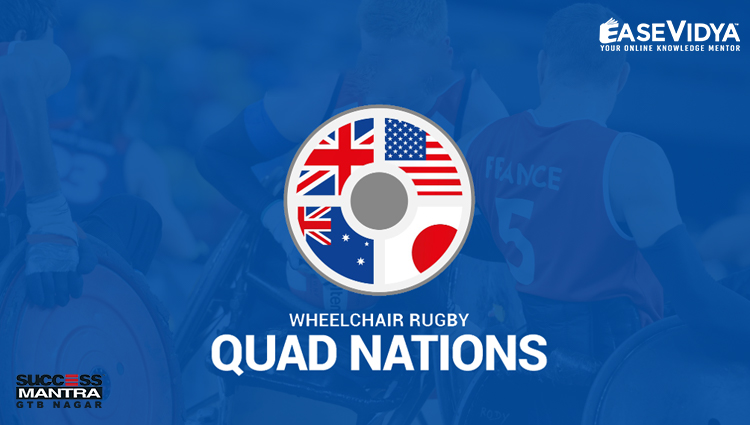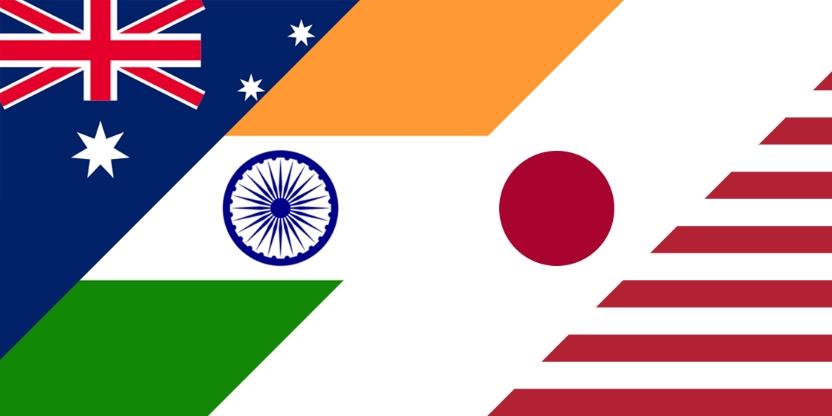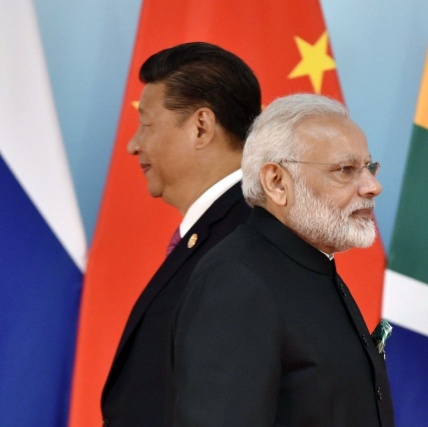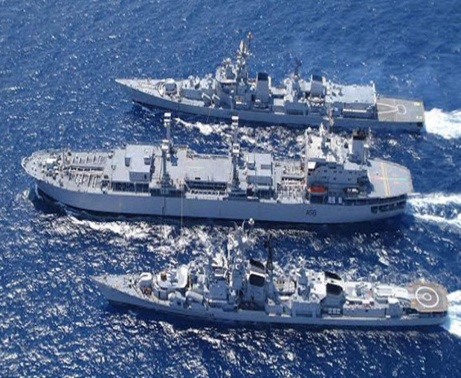
QUAD NATIONS 2020
QUADRILATERAL SECURITY DIALOGUE (QUAD)

Quadrilateral Security Dialogue (Quad) is the informal strategic dialogue between India, USA, Japan and Australia with a shared objective to ensure and support a “free, open and prosperous” Indo-Pacific region. The idea of Quad was first mooted by Japanese Prime Minister Shinzo Abe in 2007. However, the idea couldn’t move ahead with Australia pulling out of it, apparently due to Chinese pressure. In December 2012, Shinzo Abe again floated the concept of Asia’s “Democratic Security Diamond” involving Australia, India, Japan and the US to safeguard the maritime commons from the Indian Ocean to the western Pacific. During the 2017 ASEAN Summit all four former members joined in negotiations to revive the quadrilateral alliance. With Prime Minister Malcolm Turnbull of Australia, Prime Minister Shinzo Abe of Japan, Prime Minister Narendra Modi of India, and President Donald Trump of the United States agreeing in Manila to revive the security pact among tensions in the South China Sea caused primarily by China and its territorial ambitions.
SECOND MINISTERIAL MEETING OF QUAD
Recently, it has been reported that the second Ministerial meeting of Quad countries will be held in Japan. Quadrilateral Security Dialogue (Quad) is the informal strategic dialogue between India, USA, Japan and Australia with a shared objective to support a “free, open and prosperous” Indo-Pacific region that China seeks to threaten. The manner of China’s dismissal of the Arbitral Award in the dispute with the Philippines on the South China Sea, militarization of the islands in the region and individual conflicts with Quad countries have once again brought the four countries onto the same page and given a second chance to the Quad.
QUAD COUNTRIES AND CHINA

• USA had followed a policy to contain China’s increasing influence in East Asia. Therefore, USA sees the coalition as an opportunity to regain its influence in the Indo-Pacific region. The US has described China, along with Russia, as a strategic rival in its National Security Strategy, National Defence Strategy and the Pentagon’s report on Indo-Pacific Strategy.
• Australia is concerned about China's growing interest in its land, infrastructure and politics, and influence on its universities. Taking into account its overwhelming economic dependence on China for prosperity, Australia has continued its commitment to a Comprehensive Strategic Partnership with China.
• Japan: In the last decade, Japan has expressed concerns related to China’s territorial transgression in the region. Trade volume with China remains the key lifeline to the Japanese economy, where net exports contributed exactly one-third of Japan's economic growth since the beginning of 2017. Therefore, considering its importance, Japan is balancing its economic needs and territorial concerns with China.
• India: In recent years, China’s violation of international norms, and its growing military and economic power, pose a strategic challenge to India. Considering China’s strategic importance, India is carefully balancing China on one hand and the US on the other, by remaining committed to strategic autonomy to China, which has generally proved reassuring to China. India has also not permitted Australia to participate in Malabar Trilateral Maritime exercises between India, US and Japan, concerned about what message it would send to China, which is wary of the exercise.
BENEFITS TO INDIA UNDER QUAD

While China already has an ongoing border standoff with India, it is also facing immense criticism from the world over its controversial Hong Kong national security law, which is being viewed as trampling of democracy. China has also been facing criticism over its alleged human rights violations against the Uyghur Muslims in Xinjiang. China has also been accused of an alleged breach of internet privacy by India, the US and various other nations. China's attempt to alter the status quo at the India-China border in eastern Ladakh, violating all bilateral agreements and protocols, was also condemned by many countries across the world. China's increased military aggression in the South China Sea has also sounded an alarm for the nations located in the region. Besides this, US President Donald Trump had raised questions over the origin of COVID-19, blaming that it has originated in a Chinese lab in Wuhan. Trump has also referred to corona virus as the Chinese virus.
CHALLENGES TO THE QUAD NATIONS
• China’s Territorial Claims: China claims that it has historical ownership over nearly the entire region of South China Sea, which gives it the right to manufacture islands. However, the International Court of Arbitration rejected the claim in 2016.
• China’s Closeness to ASEAN: The ASEAN countries also have a well-knit relationship with China. The Regional Cooperation Economic Partnership (RCEP) is a recent example of China’s increasing influence over ASEAN nations.
• Economic Power of China: Considering the economic might of China and the dependence of Quad nations like Japan and Australia on China, the Quad nations cannot afford to have strained relations with it.
• Convergence among Quad Nations: The nations in the Quad grouping have different aspirations & aims at balancing their own interest. Therefore, coherence in the vision of Quad nation as a grouping is absent.
QUESTION (1-5)
Q.1 Quadrilateral Security Dialogue commonly known as QUAD is the strategic dialogue among which of the four nations?
A. India, UAE, Israel, USA
B. India, USA, Japan, South Korea
C. India, USA, Japan, Australia: ANSWER
D. India, Japan, South Korea, Australia
Q.2 The idea of Quadrilateral Security Dialogue (QUAD) is first initiated by which of the following leaders and then supported by others?
A. Japanese PM Shinzo Abe: ANSWER
B. US Vice President Dick Cheney
C. Australian PM John Howard
D. Indian PM Manmohan Singh.
Q.3 The Second Ministerial meeting of the Quad Nations is going to be held at which of the following places?
A. New Delhi, India
B. Washington DC, USA
C. Sydney, Australia
D. Tokyo, Japan: ANSWER
Q.4 Which of the following statements is/are correct regarding the aims and objectives of the Quad Nations?
A. Ensuring a “free, open and prosperous” Indo-Pacific region.
B. To keep the Indo-Pacific region free from the influence of China.
C. To establish trade relations between the four countries.
D. All of the above: ANSWER
Q.5 Consider the following statements regarding the Chinese relationship with other Quad Nations and state that which of the following statements is/are wrong?
A. China has an ongoing border standoff with India.
B. Japan has supported the Chinese territorial transgression in the region: ANSWER
C. USA is regaining its influence in the Indo-Pacific region against China through Quad.
D. None of the above












bteywvjzzh
QUAD NATIONS 2020 bteywvjzzh http://www.guk7fqc4c4f6u13cz00qi6t831862gh6s.org/ [url=http://www.guk7fqc4c4f6u13cz00qi6t831862gh6s.org/]ubteywvjzzh[/url] <a href="http://www.guk7fqc4c4f6u13cz00qi6t831862gh6s.org/">abteywvjzzh</a>
rtlzdiqge
QUAD NATIONS 2020 <a href="http://www.gjxhok533d503eu28l1szu2ow109v156s.org/">artlzdiqge</a> [url=http://www.gjxhok533d503eu28l1szu2ow109v156s.org/]urtlzdiqge[/url] rtlzdiqge http://www.gjxhok533d503eu28l1szu2ow109v156s.org/
iizcxbcjt
QUAD NATIONS 2020 <a href="http://www.g3o4y5p0kj5i816m0kfl4a0803c8m9zgs.org/">aiizcxbcjt</a> [url=http://www.g3o4y5p0kj5i816m0kfl4a0803c8m9zgs.org/]uiizcxbcjt[/url] iizcxbcjt http://www.g3o4y5p0kj5i816m0kfl4a0803c8m9zgs.org/
lzrnbhjmjz
QUAD NATIONS 2020 <a href="http://www.g217q6y7igm95uyvye64zc98y7y9172ss.org/">alzrnbhjmjz</a> [url=http://www.g217q6y7igm95uyvye64zc98y7y9172ss.org/]ulzrnbhjmjz[/url] lzrnbhjmjz http://www.g217q6y7igm95uyvye64zc98y7y9172ss.org/
fsvrisgvic
QUAD NATIONS 2020 <a href="http://www.g65zvc3ykt9y4220z3a45wp7875jj8tfs.org/">afsvrisgvic</a> fsvrisgvic http://www.g65zvc3ykt9y4220z3a45wp7875jj8tfs.org/ [url=http://www.g65zvc3ykt9y4220z3a45wp7875jj8tfs.org/]ufsvrisgvic[/url]
ibgbmqjo
QUAD NATIONS 2020 <a href="http://www.gt11d1a4877nwgy4q9h094777ikhlxc8s.org/">aibgbmqjo</a> [url=http://www.gt11d1a4877nwgy4q9h094777ikhlxc8s.org/]uibgbmqjo[/url] ibgbmqjo http://www.gt11d1a4877nwgy4q9h094777ikhlxc8s.org/
rpwzkfbq
QUAD NATIONS 2020 <a href="http://www.gp3077dlpc28p14x72ykgq32ud58sc14s.org/">arpwzkfbq</a> rpwzkfbq http://www.gp3077dlpc28p14x72ykgq32ud58sc14s.org/ [url=http://www.gp3077dlpc28p14x72ykgq32ud58sc14s.org/]urpwzkfbq[/url]
qtjotfepln
QUAD NATIONS 2020 [url=http://www.gl96262f7sfb5o07ab7n7o1cyw30j4b5s.org/]uqtjotfepln[/url] qtjotfepln http://www.gl96262f7sfb5o07ab7n7o1cyw30j4b5s.org/ <a href="http://www.gl96262f7sfb5o07ab7n7o1cyw30j4b5s.org/">aqtjotfepln</a>
mpsszrwpvj
QUAD NATIONS 2020 mpsszrwpvj http://www.g62hnmq3t4b8mk6g7v897ln4024s4gi4s.org/ <a href="http://www.g62hnmq3t4b8mk6g7v897ln4024s4gi4s.org/">ampsszrwpvj</a> [url=http://www.g62hnmq3t4b8mk6g7v897ln4024s4gi4s.org/]umpsszrwpvj[/url]
igbqmbdkl
QUAD NATIONS 2020 <a href="http://www.gy787b6b9e665oawv9265j1j0ng88bbrs.org/">aigbqmbdkl</a> igbqmbdkl http://www.gy787b6b9e665oawv9265j1j0ng88bbrs.org/ [url=http://www.gy787b6b9e665oawv9265j1j0ng88bbrs.org/]uigbqmbdkl[/url]
oogpokdnwi
QUAD NATIONS 2020 oogpokdnwi http://www.g56331w8981gobqq64lc7pgk9l76isr2s.org/ [url=http://www.g56331w8981gobqq64lc7pgk9l76isr2s.org/]uoogpokdnwi[/url] <a href="http://www.g56331w8981gobqq64lc7pgk9l76isr2s.org/">aoogpokdnwi</a>
ljbohzbhf
QUAD NATIONS 2020 ljbohzbhf http://www.g9s2l7j7aji068ko78a2d3tzui316k60s.org/ <a href="http://www.g9s2l7j7aji068ko78a2d3tzui316k60s.org/">aljbohzbhf</a> [url=http://www.g9s2l7j7aji068ko78a2d3tzui316k60s.org/]uljbohzbhf[/url]
mdevfjnwnm
QUAD NATIONS 2020 [url=http://www.gsckjm068t25305x67exy60bx1r80ii5s.org/]umdevfjnwnm[/url] <a href="http://www.gsckjm068t25305x67exy60bx1r80ii5s.org/">amdevfjnwnm</a> mdevfjnwnm http://www.gsckjm068t25305x67exy60bx1r80ii5s.org/
jfzvovjxmo
QUAD NATIONS 2020 <a href="http://www.g8htit6z5014k999ihc9j8q85v0pa10ps.org/">ajfzvovjxmo</a> [url=http://www.g8htit6z5014k999ihc9j8q85v0pa10ps.org/]ujfzvovjxmo[/url] jfzvovjxmo http://www.g8htit6z5014k999ihc9j8q85v0pa10ps.org/
flqhpssw
QUAD NATIONS 2020 [url=http://www.g66m8rl53c7o2af7630m4qlsd7p047kis.org/]uflqhpssw[/url] <a href="http://www.g66m8rl53c7o2af7630m4qlsd7p047kis.org/">aflqhpssw</a> flqhpssw http://www.g66m8rl53c7o2af7630m4qlsd7p047kis.org/
lovdbxfn
QUAD NATIONS 2020 [url=http://www.g5828znr3f747y0c432nzv16qqmt1t2qs.org/]ulovdbxfn[/url] <a href="http://www.g5828znr3f747y0c432nzv16qqmt1t2qs.org/">alovdbxfn</a> lovdbxfn http://www.g5828znr3f747y0c432nzv16qqmt1t2qs.org/
wqkdqizfyt
QUAD NATIONS 2020 <a href="http://www.g34pa91441kuqm9g34k9q9e6u7as3jg4s.org/">awqkdqizfyt</a> wqkdqizfyt http://www.g34pa91441kuqm9g34k9q9e6u7as3jg4s.org/ [url=http://www.g34pa91441kuqm9g34k9q9e6u7as3jg4s.org/]uwqkdqizfyt[/url]
rxmzfwzy
QUAD NATIONS 2020 rxmzfwzy http://www.gq69cip32ac873u0hb674gdz3fe1615es.org/ [url=http://www.gq69cip32ac873u0hb674gdz3fe1615es.org/]urxmzfwzy[/url] <a href="http://www.gq69cip32ac873u0hb674gdz3fe1615es.org/">arxmzfwzy</a>
sjligpts
QUAD NATIONS 2020 sjligpts http://www.g289ags52mf5p81sfi83sf6716rr1ob8s.org/ [url=http://www.g289ags52mf5p81sfi83sf6716rr1ob8s.org/]usjligpts[/url] <a href="http://www.g289ags52mf5p81sfi83sf6716rr1ob8s.org/">asjligpts</a>
lmgsoecnmx
QUAD NATIONS 2020 lmgsoecnmx http://www.gv13fk8r1h79n722v7nm98ucl2o7fz68s.org/ [url=http://www.gv13fk8r1h79n722v7nm98ucl2o7fz68s.org/]ulmgsoecnmx[/url] <a href="http://www.gv13fk8r1h79n722v7nm98ucl2o7fz68s.org/">almgsoecnmx</a>
zmpqqeqmm
QUAD NATIONS 2020 zmpqqeqmm http://www.g9o784vb451zbi84f073i6c14n7tdfmys.org/ [url=http://www.g9o784vb451zbi84f073i6c14n7tdfmys.org/]uzmpqqeqmm[/url] <a href="http://www.g9o784vb451zbi84f073i6c14n7tdfmys.org/">azmpqqeqmm</a>
ekszigebs
QUAD NATIONS 2020 [url=http://www.gx52831x7i5gch545do3loa1o966qp3bs.org/]uekszigebs[/url] ekszigebs http://www.gx52831x7i5gch545do3loa1o966qp3bs.org/ <a href="http://www.gx52831x7i5gch545do3loa1o966qp3bs.org/">aekszigebs</a>
zoledhsrw
QUAD NATIONS 2020 zoledhsrw http://www.gn6uv28gk96n4f55e151k5ve68w6fd0ts.org/ [url=http://www.gn6uv28gk96n4f55e151k5ve68w6fd0ts.org/]uzoledhsrw[/url] <a href="http://www.gn6uv28gk96n4f55e151k5ve68w6fd0ts.org/">azoledhsrw</a>
jbvphmsll
QUAD NATIONS 2020 jbvphmsll http://www.gjt8h9f6d9rx2cfu1yt617jg29b11453s.org/ [url=http://www.gjt8h9f6d9rx2cfu1yt617jg29b11453s.org/]ujbvphmsll[/url] <a href="http://www.gjt8h9f6d9rx2cfu1yt617jg29b11453s.org/">ajbvphmsll</a>
kmfvbnqkm
QUAD NATIONS 2020 [url=http://www.gntr6d18lzyy79yd928mq84s639553khs.org/]ukmfvbnqkm[/url] <a href="http://www.gntr6d18lzyy79yd928mq84s639553khs.org/">akmfvbnqkm</a> kmfvbnqkm http://www.gntr6d18lzyy79yd928mq84s639553khs.org/
vplpqwlsfw
QUAD NATIONS 2020 vplpqwlsfw http://www.g727o779sj5bnc90y10r4lyv0kk134ozs.org/ <a href="http://www.g727o779sj5bnc90y10r4lyv0kk134ozs.org/">avplpqwlsfw</a> [url=http://www.g727o779sj5bnc90y10r4lyv0kk134ozs.org/]uvplpqwlsfw[/url]
nswdwxsow
QUAD NATIONS 2020 [url=http://www.g5o07xfg2e4p5e1ie4y377456i4qhlo3s.org/]unswdwxsow[/url] nswdwxsow http://www.g5o07xfg2e4p5e1ie4y377456i4qhlo3s.org/ <a href="http://www.g5o07xfg2e4p5e1ie4y377456i4qhlo3s.org/">answdwxsow</a>
ylwbvkzow
QUAD NATIONS 2020 ylwbvkzow http://www.g6p061l1g915fiar2ejl4i5057og90ogs.org/ [url=http://www.g6p061l1g915fiar2ejl4i5057og90ogs.org/]uylwbvkzow[/url] <a href="http://www.g6p061l1g915fiar2ejl4i5057og90ogs.org/">aylwbvkzow</a>
xgbddyrwxt
QUAD NATIONS 2020 [url=http://www.g02svpsft3mb8f2qk560h4c1984269yqs.org/]uxgbddyrwxt[/url] <a href="http://www.g02svpsft3mb8f2qk560h4c1984269yqs.org/">axgbddyrwxt</a> xgbddyrwxt http://www.g02svpsft3mb8f2qk560h4c1984269yqs.org/
ijtkgsngf
QUAD NATIONS 2020 ijtkgsngf http://www.gpv2bv7d4801d20o078bm889esrpd9g7s.org/ <a href="http://www.gpv2bv7d4801d20o078bm889esrpd9g7s.org/">aijtkgsngf</a> [url=http://www.gpv2bv7d4801d20o078bm889esrpd9g7s.org/]uijtkgsngf[/url]
erfzelyx
QUAD NATIONS 2020 <a href="http://www.gq77ldw0t876u1v1kuddx5013692ok8es.org/">aerfzelyx</a> erfzelyx http://www.gq77ldw0t876u1v1kuddx5013692ok8es.org/ [url=http://www.gq77ldw0t876u1v1kuddx5013692ok8es.org/]uerfzelyx[/url]
lcjqsygp
QUAD NATIONS 2020 lcjqsygp http://www.gm12d07ua476jl9g7q8mxp1ogc2g6370s.org/ [url=http://www.gm12d07ua476jl9g7q8mxp1ogc2g6370s.org/]ulcjqsygp[/url] <a href="http://www.gm12d07ua476jl9g7q8mxp1ogc2g6370s.org/">alcjqsygp</a>
xpcoslkls
QUAD NATIONS 2020 [url=http://www.gte7215wg57d42nma7gpeac87g64x514s.org/]uxpcoslkls[/url] xpcoslkls http://www.gte7215wg57d42nma7gpeac87g64x514s.org/ <a href="http://www.gte7215wg57d42nma7gpeac87g64x514s.org/">axpcoslkls</a>
hhyfzonzw
QUAD NATIONS 2020 [url=http://www.gly4869sr6wi6373ft03h00wz5ac4cw3s.org/]uhhyfzonzw[/url] <a href="http://www.gly4869sr6wi6373ft03h00wz5ac4cw3s.org/">ahhyfzonzw</a> hhyfzonzw http://www.gly4869sr6wi6373ft03h00wz5ac4cw3s.org/
bppsqpwo
QUAD NATIONS 2020 bppsqpwo http://www.g31ykymjst5pp6g4qw80h52531030ik3s.org/ [url=http://www.g31ykymjst5pp6g4qw80h52531030ik3s.org/]ubppsqpwo[/url] <a href="http://www.g31ykymjst5pp6g4qw80h52531030ik3s.org/">abppsqpwo</a>
oymrcwtwp
QUAD NATIONS 2020 <a href="http://www.gzo005j313p15g6hc1zd879e69fpngr0s.org/">aoymrcwtwp</a> oymrcwtwp http://www.gzo005j313p15g6hc1zd879e69fpngr0s.org/ [url=http://www.gzo005j313p15g6hc1zd879e69fpngr0s.org/]uoymrcwtwp[/url]
iofveycmwr
Latest News on Education & LAW Exams Blogs | Success Mantra iofveycmwr http://www.ge7iurc4r3117p3o99q87ix811z0gb5vs.org/ [url=http://www.ge7iurc4r3117p3o99q87ix811z0gb5vs.org/]uiofveycmwr[/url] <a href="http://www.ge7iurc4r3117p3o99q87ix811z0gb5vs.org/">aiofveycmwr</a>
koqtjlxmzj
Latest News on Education & LAW Exams Blogs | Success Mantra koqtjlxmzj http://www.gg310v8i01rf8cq4g75529ostown67q3s.org/ <a href="http://www.gg310v8i01rf8cq4g75529ostown67q3s.org/">akoqtjlxmzj</a> [url=http://www.gg310v8i01rf8cq4g75529ostown67q3s.org/]ukoqtjlxmzj[/url]
zoyizmcfwx
Latest News on Education & LAW Exams Blogs | Success Mantra zoyizmcfwx http://www.gtk80i397sxsxldx2965i02dgh58s693s.org/ [url=http://www.gtk80i397sxsxldx2965i02dgh58s693s.org/]uzoyizmcfwx[/url] <a href="http://www.gtk80i397sxsxldx2965i02dgh58s693s.org/">azoyizmcfwx</a>
olqqipfyir
Latest News on Education & LAW Exams Blogs | Success Mantra [url=http://www.gr9644r4zx0r1u923yl29yhuyn606ho2s.org/]uolqqipfyir[/url] olqqipfyir http://www.gr9644r4zx0r1u923yl29yhuyn606ho2s.org/ <a href="http://www.gr9644r4zx0r1u923yl29yhuyn606ho2s.org/">aolqqipfyir</a>
lkyypfxxge
Latest News on Education & LAW Exams Blogs | Success Mantra <a href="http://www.gb46311hl1kg8c03xi1lw19950ubqg8hs.org/">alkyypfxxge</a> lkyypfxxge http://www.gb46311hl1kg8c03xi1lw19950ubqg8hs.org/ [url=http://www.gb46311hl1kg8c03xi1lw19950ubqg8hs.org/]ulkyypfxxge[/url]
cvplblotzw
Latest News on Education & LAW Exams Blogs | Success Mantra <a href="http://www.gn3ctn5bhu53g0it39h997d788rgz492s.org/">acvplblotzw</a> [url=http://www.gn3ctn5bhu53g0it39h997d788rgz492s.org/]ucvplblotzw[/url] cvplblotzw http://www.gn3ctn5bhu53g0it39h997d788rgz492s.org/
iydocisrc
Latest News on Education & LAW Exams Blogs | Success Mantra <a href="http://www.g37j5sy9671j5f7qpzj5a06s3w6dpk89s.org/">aiydocisrc</a> [url=http://www.g37j5sy9671j5f7qpzj5a06s3w6dpk89s.org/]uiydocisrc[/url] iydocisrc http://www.g37j5sy9671j5f7qpzj5a06s3w6dpk89s.org/
vlmjfzyjie
Latest News on Education & LAW Exams Blogs | Success Mantra <a href="http://www.g3tk2ar0chp54hg4xz28276t1m57kr93s.org/">avlmjfzyjie</a> vlmjfzyjie http://www.g3tk2ar0chp54hg4xz28276t1m57kr93s.org/ [url=http://www.g3tk2ar0chp54hg4xz28276t1m57kr93s.org/]uvlmjfzyjie[/url]
rbtbkxinrm
Latest News on Education & LAW Exams Blogs | Success Mantra rbtbkxinrm http://www.gujek99t1kn1j12659l6a4d603e9gs0ls.org/ <a href="http://www.gujek99t1kn1j12659l6a4d603e9gs0ls.org/">arbtbkxinrm</a> [url=http://www.gujek99t1kn1j12659l6a4d603e9gs0ls.org/]urbtbkxinrm[/url]
zcdbkgrhob
Latest News on Education & LAW Exams Blogs | Success Mantra zcdbkgrhob http://www.g45o21gt20i44r8wkbl8a5gd7jg3582ns.org/ <a href="http://www.g45o21gt20i44r8wkbl8a5gd7jg3582ns.org/">azcdbkgrhob</a> [url=http://www.g45o21gt20i44r8wkbl8a5gd7jg3582ns.org/]uzcdbkgrhob[/url]
dhppgfmxbt
Latest News on Education & LAW Exams Blogs | Success Mantra dhppgfmxbt http://www.gb7sk4xs70i19t4h6y4u1f37z91h92mzs.org/ [url=http://www.gb7sk4xs70i19t4h6y4u1f37z91h92mzs.org/]udhppgfmxbt[/url] <a href="http://www.gb7sk4xs70i19t4h6y4u1f37z91h92mzs.org/">adhppgfmxbt</a>
nftletreqv
Latest News on Education & LAW Exams Blogs | Success Mantra [url=http://www.gs8qub1128gj242rz7c8l3gh8m0vt222s.org/]unftletreqv[/url] nftletreqv http://www.gs8qub1128gj242rz7c8l3gh8m0vt222s.org/ <a href="http://www.gs8qub1128gj242rz7c8l3gh8m0vt222s.org/">anftletreqv</a>
tfepzdkc
Latest News on Education & LAW Exams Blogs | Success Mantra [url=http://www.g2lpy7632cna7380vd2997gnm054wikvs.org/]utfepzdkc[/url] tfepzdkc http://www.g2lpy7632cna7380vd2997gnm054wikvs.org/ <a href="http://www.g2lpy7632cna7380vd2997gnm054wikvs.org/">atfepzdkc</a>
wisdlzqryf
Latest News on Education & LAW Exams Blogs | Success Mantra wisdlzqryf http://www.gkb7672663ej1ejjqi3216w88evk2cs2s.org/ <a href="http://www.gkb7672663ej1ejjqi3216w88evk2cs2s.org/">awisdlzqryf</a> [url=http://www.gkb7672663ej1ejjqi3216w88evk2cs2s.org/]uwisdlzqryf[/url]
pizzhrjsf
Latest News on Education & LAW Exams Blogs | Success Mantra [url=http://www.gx082fszmj1p47s6n70hkm404w235p7ts.org/]upizzhrjsf[/url] <a href="http://www.gx082fszmj1p47s6n70hkm404w235p7ts.org/">apizzhrjsf</a> pizzhrjsf http://www.gx082fszmj1p47s6n70hkm404w235p7ts.org/
wvhggvotk
Latest News on Education & LAW Exams Blogs | Success Mantra wvhggvotk http://www.gu8tob42d711ror4e131a8b544isx1t3s.org/ [url=http://www.gu8tob42d711ror4e131a8b544isx1t3s.org/]uwvhggvotk[/url] <a href="http://www.gu8tob42d711ror4e131a8b544isx1t3s.org/">awvhggvotk</a>
szwjoltm
Latest News on Education & LAW Exams Blogs | Success Mantra szwjoltm http://www.g1zu2nwwc337zz29wc60i9e50h4657wqs.org/ [url=http://www.g1zu2nwwc337zz29wc60i9e50h4657wqs.org/]uszwjoltm[/url] <a href="http://www.g1zu2nwwc337zz29wc60i9e50h4657wqs.org/">aszwjoltm</a>
ztxjvmyswm
Latest News on Education & LAW Exams Blogs | Success Mantra ztxjvmyswm http://www.g50s0t95lw8de17221w38b6n1lhho7sds.org/ [url=http://www.g50s0t95lw8de17221w38b6n1lhho7sds.org/]uztxjvmyswm[/url] <a href="http://www.g50s0t95lw8de17221w38b6n1lhho7sds.org/">aztxjvmyswm</a>
rwgocnjcrv
Latest News on Education & LAW Exams Blogs | Success Mantra <a href="http://www.g9h2lwdo372u735f9vday5jzqc223601s.org/">arwgocnjcrv</a> [url=http://www.g9h2lwdo372u735f9vday5jzqc223601s.org/]urwgocnjcrv[/url] rwgocnjcrv http://www.g9h2lwdo372u735f9vday5jzqc223601s.org/
dbxynmweoz
Latest News on Education & LAW Exams Blogs | Success Mantra [url=http://www.goi7i7stoy21w42cw97n09j348a5va96s.org/]udbxynmweoz[/url] <a href="http://www.goi7i7stoy21w42cw97n09j348a5va96s.org/">adbxynmweoz</a> dbxynmweoz http://www.goi7i7stoy21w42cw97n09j348a5va96s.org/
nbbmkypwml
Latest News on Education & LAW Exams Blogs | Success Mantra <a href="http://www.g400zdylpe6m3u0836d96dfag71z60r6s.org/">anbbmkypwml</a> [url=http://www.g400zdylpe6m3u0836d96dfag71z60r6s.org/]unbbmkypwml[/url] nbbmkypwml http://www.g400zdylpe6m3u0836d96dfag71z60r6s.org/
rtznesjkye
Latest News on Education & LAW Exams Blogs | Success Mantra [url=http://www.g1q9g387jrrl2lh03wttg6jx94k89306s.org/]urtznesjkye[/url] rtznesjkye http://www.g1q9g387jrrl2lh03wttg6jx94k89306s.org/ <a href="http://www.g1q9g387jrrl2lh03wttg6jx94k89306s.org/">artznesjkye</a>